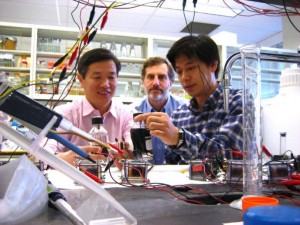Apr
1
Bruce E. Logan, Kappe Professor of Environmental Engineering at Penn State University and his team discovered a process that dramatically improves methane, the main part of natural gas production from microbes by adding a slight electrical current. The paper published this week in Environmental Science and Technology discussed an optimal result of capturing the current with up to 96% efficiency.
As a natural gas production or as a storage form of renewable electricity production, this is surely a marketplace disruptive event. The team’s experiments led to an 80% low efficiency rating – which for storage from renewables would be tolerable.
The story from the Penn State press release on finding the serendipitous innovation as Logan puts it, “We were studying making hydrogen in microbial electrolysis cells and we kept getting all this methane. We may now understand why.”
Methanogenic microorganisms produce methane in marshes and dumps, but scientists have thought that the organisms turned hydrogen or organic materials, such as acetate, into the methane. However, the Logan team found, while trying to produce hydrogen in microbial electrolysis cells, that their cells produced much more methane than expected.
“All the methane generation going on in nature that we have assumed is going through hydrogen may not be,” said Logan. “We actually find very little hydrogen in the gas phase in nature. Perhaps where we assumed hydrogen is being made, it is not.”
In the initial experiment with microbial electrolysis cells an electrical voltage is required to be added to the natural voltage produced by bacteria using organic materials to produce current that produces the hydrogen. The team learned that the Archaea microbe, using about the same electrical input, could use the current to convert carbon dioxide and water to methane without any organic material, bacteria or hydrogen usually found in microbial electrolysis cells. There’s your “eureka!” moment. Must make the wind and solar storage folks and the global CO2 controllers smile.
The result – Logan puts it plainly, “We have a microbe that is self perpetuating that can accept electrons directly, and use them to create methane.” It’s almost unnerving in its simplicity.
This innovation is obviously going places so lets get the team members named on the post. They are Shaoan Cheng, senior research associate; Defeng Xing, post doctoral researcher, and Douglas F. Call, graduate student, environmental engineering. Congratulations! It’s a great example of research investing coming up with something off the original mark, yet extremely worthwhile and valuable.
The finer details are the team created a two-chambered cell with an anode immersed in water on one side of the chamber and a cathode in water, inorganic nutrients and carbon dioxide on the other side of the chamber. They applied a voltage, but recorded only a minute current. The researchers then coated the cathode with the biofilm of Archaea and not only did current flow in the circuit, but the cell produced methane.
Logan says, “The only way to get current at the voltage we used was if the microbes were directly accepting electrons.” Another key he notes, is the electrochemical reaction takes place without any precious metal catalysts and at a lower energy level than converting carbon dioxide to methane using conventional, non-biological methods. Maybe it really will be a cheap technology.
If the electricity comes from a non-carbon source such as wind or solar power they’d be carbon neutral. The process doesn’t sequester carbon; it recycles it into new fuel. If the carbon is recaptured in each cycle it stays carbon neutral.
Logan reminds gently that methane is preferred over hydrogen because a large portion of the U.S. infrastructure is already set up to easily transport and deliver methane. He also notes it would be a great way for off peak capture of renewable energy into transport, home heating, commercial, and industrial fuel.
The quick sensation is that producers of CO2 suddenly have a revenue source instead of a cap and tax problem if they so choose.
Are we really sure we want to lose all that CO2 to sequestration?
Might want to think that through without the global warming hysteria bringing such damning bias to the science.
Go guys! And thanks to the National Science Foundation and Air Products and Chemicals, Inc. who provided the project support.
Comments
7 Comments so far



[…] Read the original post: Boosting Bugs with Electricity to Make Natural Gas From C02 […]
[…] (not a joke, but wouldn’t it be ironic?): Penn State researchers have discovered how to use microbes to make natural gas from . . . (wait for it) . . . CO2! (Hat tip to Tim Taylor; many thanks for the link!) Key graf: The team learned that the Archaea […]
[…] See more here: Boosting Bugs with Electricity to Make Natural Gas From C02 | New … […]
Hydrogen Peroxide Uses, Hydrogen Peroxide Therapy, H2O2…
To whiten teeth rinse your mouth out with Hydrogen Peroxide before each brushing. In a jar or bowl make a paste using baking soda and hydrogen peroxide to use in place of toothpaste and brush with this after rinsing. The hydrogen peroxide does not tast…
Your blog is very useful. Thank you so much for giving plenty of awesome information. I will bookmark your blog site and will be without doubt coming back. Once again, I appreciate all your work and also providing a lot great ideas for your readers.
Couldnt agree more with that, very attractive article
This is a fantastic development. I would really like to know more and in particular, how I can make it at home?